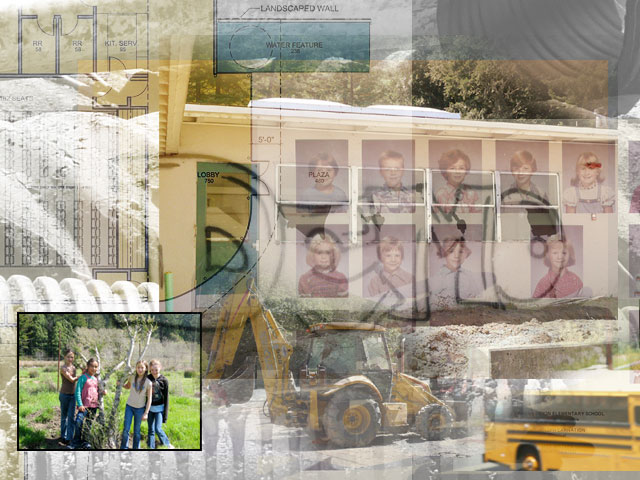Re-membering Harmony

Site-specific performance / installation: go to www.occidentalcenterforthearts.com
Re-Membering Harmony was a site-specific Digital Theatre piece I worked on with the Virtual Performance Collaborative for the Occidental Center for the Arts (OCA) under the model of The Talking Birds (a prominent community based devise theatre group creating media rich performances in site-specific venues).
The site was the old Harmony School campus (a rural K-8 school in Western Sonoma County, CA--north of San Francisco) which sat vacant for years and is now being repurposed as housing and a performing arts center. As part of that transition, which has struck some local residents as difficult, I collected oral histories of the school, and shaped them into an accessible memory log and on-site interactive performance with images of the past layered on the present...
The overall process of creating Re-Membering Harmony was one of: research and digitizing archival material (including yearbooks and two teachers’ archives), collecting oral histories from teachers, staff, and students, documenting the site’s transformation, involving the new school and local community, mapping the site for performance areas, transcribing interviews and devising a script, editing media assets and collecting equipment, and rehearsing onsite with local actors-collaborators and rigging the space with interactive media.
At the core of the Re-Membering Harmony project was collecting people’s stories of the school (and the town). This process took two years, in which time I interviewed over sixty-five people. Bakhtin’s term, heteroglossia, or of many voices speaking (to create the rebellious voice of the folk, or community) is a excellent way of understanding what emerged from this oral history gathering process which collected stories across generations, societal roles, and political lines.
The performance was developed through a combination of methods including: transcription based choices, learning the logic of the performance route, script pieces developed by actors, group and individual improvisation. Rather than act as a script, the transcription was a tool to influence actor-originated choices. In rehearsal I would feed the actors bits of information and lines from the transcription (and use video to help base composite characters). This led to the inclusion of details (like the presidential fitness test, Halloween parade through town, and camping trips Camp Cazadero), the seeming flotsam and jetsam of the mind but which appeared in so many interviewee’s retellings of the past, that they began to assert themselves through repetition as major threads of experience within the school’s malleable, yet enduring culture. This also helped steer actor choices in creating characters with some elements of reality at their core and eventually became keywords which stimulated the audience’s memories and sense of place.
In some ways the school was a community in itself; a living organism within the town, built on the invisible networks and social currents between kids, teachers, staff, and parents. The performance at the old school gave voice to the invisible cultures of the playground, and it both valued and complicated the creation of memory. It was an experiment somewhere between history, community activism, media, and theatre; an experiment in re-creating a place for memory. I hope that the outcome of re-membering Harmony school (including preserving these memories at the OCA) will be to continue to reinvest the town with a sense of pride and ownership of its near past and bring this energy to the new school and art center, reinvigorating the town’s sense of community. Re-Membering Harmony was a project of transformation: acknowledging the past and claiming the future, valuing and strengthening the local, collectively building who we are.
